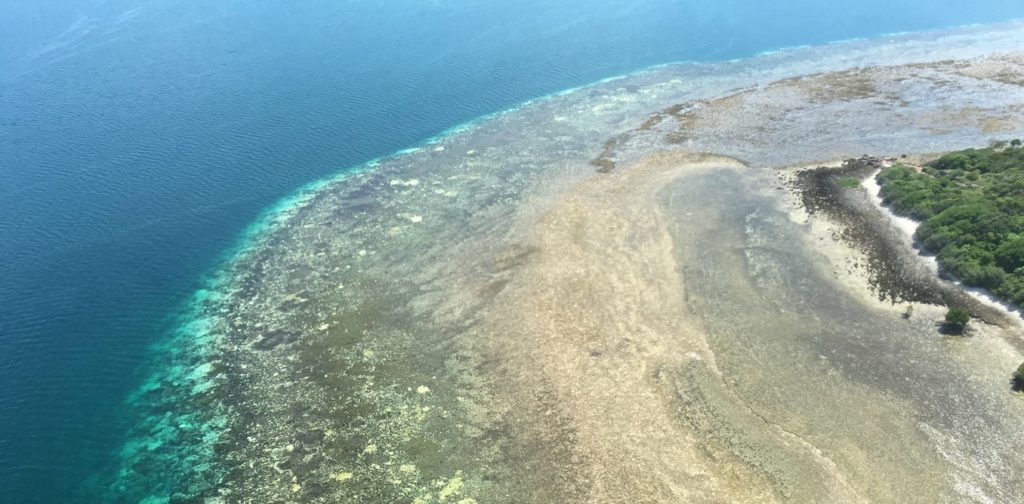The tourism industry is reeling after two shocking revelations about the condition of the Great Barrier Reef emerged, raising grave concerns for the future of the natural wonder.
A new aerial survey revealed that back-to-back annual coral bleaching events have affected two-thirds of the Great Barrier Reef.
Scientists said record-breaking warm waters along the Queensland coast had triggered widespread bleaching over 1500 kilometres of the World-Heritage-listed reef over the two summers. The worst of the bleaching has occurred further south than last year’s event, in the popular tourist sector between Townsville and Cairns.
“The combined impact of this back-to-back bleaching stretches for 1,500 km (900 miles), leaving only the southern third unscathed,” says Prof. Terry Hughes, Director of the ARC Centre of Excellence for Coral Reef Studies.
“The bleaching is caused by record-breaking temperatures driven by global warming. This year, 2017, we are seeing mass bleaching, even without the assistance of El Niño conditions.”
“It takes at least a decade for a full recovery of even the fastest growing corals, so mass bleaching events 12 months apart offers zero prospect of recovery for reefs that were damaged in 2016,” added Dr James Kerry who also participated in the survey.
The new findings came as a study by the Queensland Parks and Wildlife Service and the Great Barrier Reef Marine Park Authority showed several of the reefs around the Whitsundays had either been destroyed or badly damaged by Cyclone Debbie which swept through the area two weeks agogenerating wind gusts up to 260 kilometres per hour.
The study will continue this week, with scientists still unsure as to the full extent of the damage wreaked by the tropical storm.
So far, it has found extensive damage to popular snorkelling spots such as Blue Pearl Bay near Hayman Island and Manta Ray Bay off Hook Island.
Reefs off Hook Island’s Luncheon Bay, Maureens Cove and Butterfly Bay are also partly destroyed.
So what can we do to help?
Fossil fuel emissions from cars and industry lead to ocean warming which causes mass-bleaching of corals and can lead to widespread destruction of reefs. Although the major issues are climate change, increased nutrients via run-off and mining, you can try to reduce your own emissions by driving less or using a fuel efficient or hybrid vehicle.
Government support of Adani’s Carmichael Mine is a particular concern, threatening to further stress the fragile reef. Letter writing can be an effective means of voicing your outrage – write a letter in your own words and send it by “snail mail” to your MP. Or check out the GetUp! campaign here.
There are also a number of organisations working tirelessly to ensure the future of the Reef – you can support them by making a donation. Some examples include Greenpeace and the Great Barrier Reef Foundation. Or you can show your support by volunteering with organisations such as the Great Barrier Reef Marine Park Authority.
Here are 10 more ways you can do your bit to help the Great Barrier Reef courtesy of Cairns-based Reefteach
 1. Support conservation organisations and marine parks, through donations, volunteering, paying visitor fees (even when voluntary), etc.
1. Support conservation organisations and marine parks, through donations, volunteering, paying visitor fees (even when voluntary), etc.
2. Help educate others about marine life and climate change.
3. Follow reef etiquette when diving and snorkelling. Choose tour operators who are eco-certified, encourage sustainable diving and snorkelling practice, and support marine conservation initiatives.
4. Follow the Three R’s – Reduce, Recycle, Reuse – whenever possible.
5. Help to reduce plastic waste – plastics can choke and entangle marine life and contain harmful chemicals that concentrate pollutants.
6. Purchase locally-grown produce (e.g. from your local farmers market)and organic produce whenever possible (to reduce fuel emissions and pesticides from transport and production). Grow your own.
7. Make sure your seafood consumption is sustainable. Abide by local fishing regulations and closed seasons, and only buy fish from fisherman or dealers you trust to do the same. Use steel (rather than stainless steel hooks) which erode more quickly if a fish breaks the line.
8. Save energy in your home – think energy efficient light bulbs and appliances, solar hot water systems, using appliances sparingly.
9. Use less-toxic household & garden products (good for you as well as the environment!)
10. Reduce fossil fuel emissions: Drive less – walk, cycle, skate, use public transport, combine errands, car-share. Buy a fuel-efficient, electric or hybrid vehicle. Offset your carbon emissions when flying.
KarryOn is proud to support this story as another fine fantastic example of our 2017 ‘Travel to change the world’ initiative. You can help by sharing this story to raise awareness and using the hashtag #traveltochangetheworld when you see a great example of good will or sustainable initiatives in travel.
Are you concerned about the future of the Great Barrier Reef?





